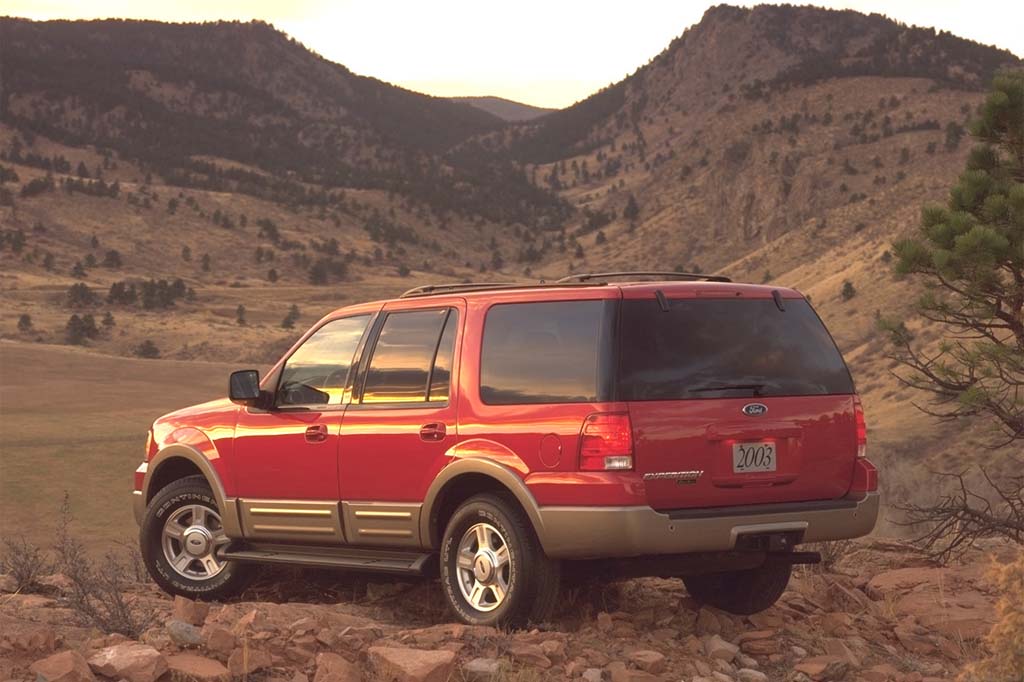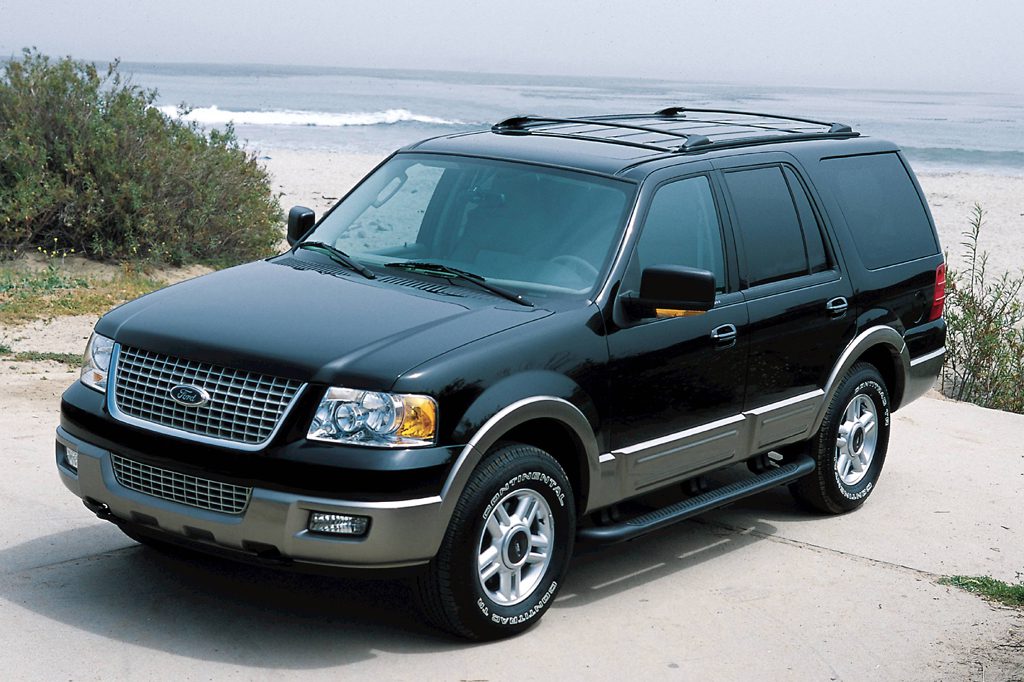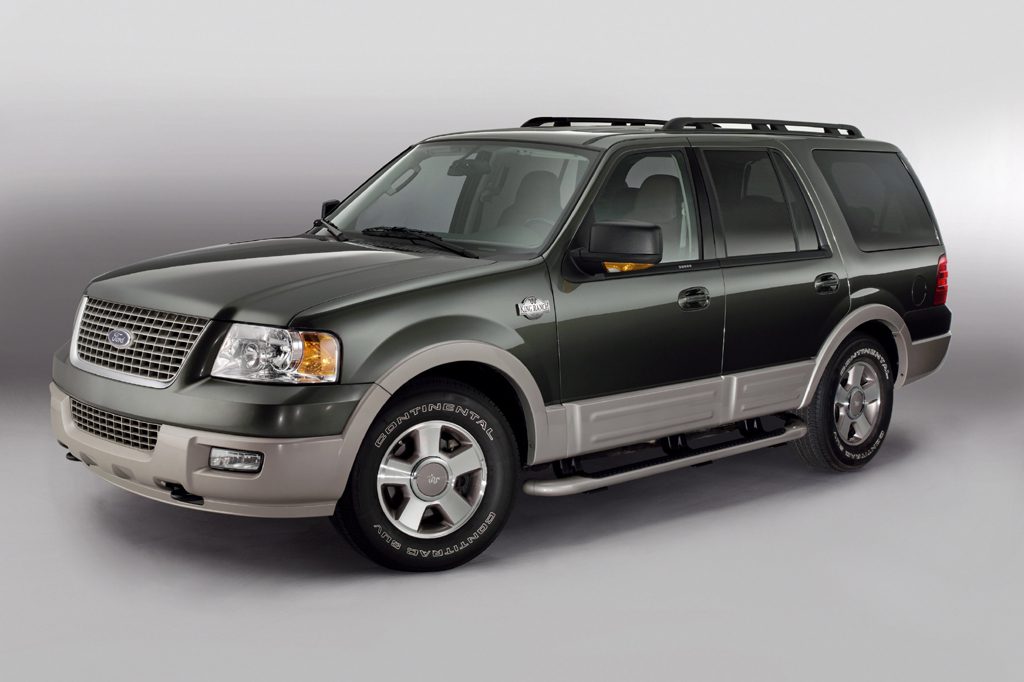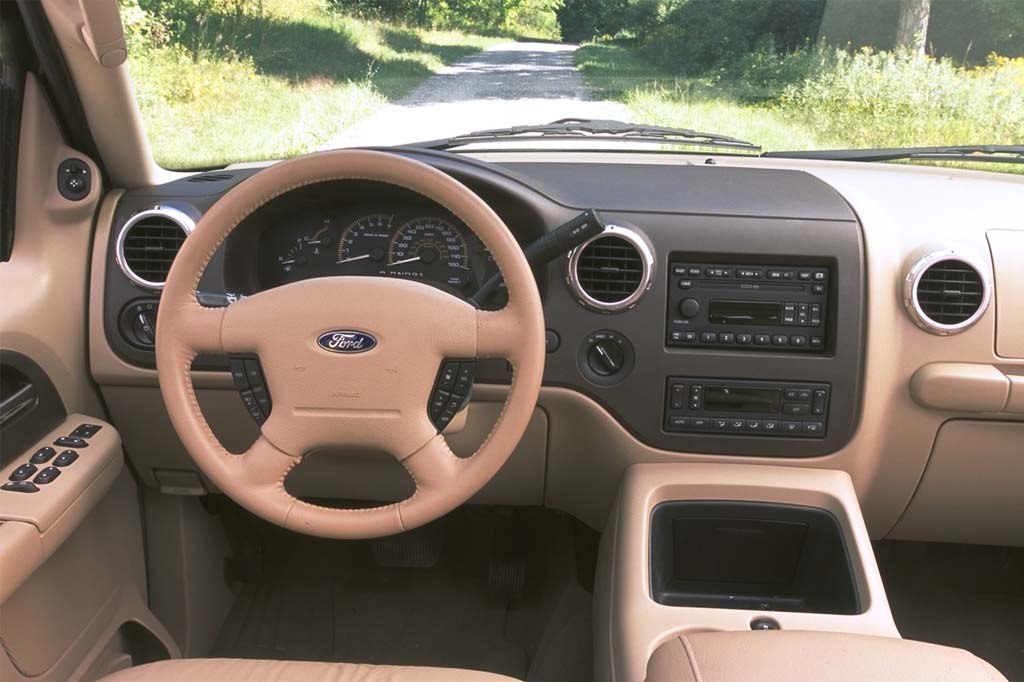| Large SUV; Built in USA |
|
|
| Good condition price range: $2,000 – $39,300* |

2003 Ford Expedition

2004 Ford Expedition

2005 Ford Expedition

Ford Expedition interior
| Pros: |
|
| Cons: |
|
Expeditions qualify as a Best Buy (2003-6 and 2008-12) because they do everything a full-size SUV should, and handle some important tasks better than most. No, Ford’s version is not as opulent as its upscale Navigator cousin, but it matches Lincoln’s array of safety and convenience features at lower cost.
Overview
A new independent rear suspension and an industry-first power fold-down third-row seat highlighted the redesigned 2003 Expedition. This full-size SUV was positioned between Ford’s midsize Explorer and the larger Excursion. New styling, inside and out, accompanied the Expedition’s wider body.
XLT and Eddie Bauer models were joined by an FX4 off-road edition. Expeditions were again available with a 4.6- or 5.4-liter V8, and either two-wheel drive or Ford’s ControlTrac four-wheel drive, which could be left engaged on dry pavement and included low-range gearing. Antilock four-wheel disc brakes continued as standard, now with brake assist for emergency stops.
Newly optional were Ford’s AdvanceTrac traction-control/antiskid system, and a tire-pressure monitor. XLTs relinquished their 16-inch wheels for the same 17-inchers as Eddie Bauer models. Replacing front side airbags as an option were curtain side airbags for the first two seating rows. The curtain airbags were designed to deploy in side collisions and in rollover accidents.
All Expeditions had three rows of seats. Value- and Popular-model XLTs were available with a front bench for nine-passenger capacity. In the second row, Eddie Bauer models could substitute two buckets for the standard bench. Exclusive to Eddie Bauer, the third-row seat power-folded into the floor, via controls in the front and back of the cabin.
Ford’s new independent rear suspension lowered the rear floor by 9 inches, adding third-row legroom. The FX4 included skid plates, off-road shock absorbers, and tubular running boards. An adjustable air suspension became available later in the model year.
Lincoln’s version of the Expedition, the Navigator, was similarly redesigned for 2003. Expedition rivals included the Chevrolet Tahoe and Suburban, GMC Yukon/Denali, and Toyota Sequoia.
Yearly Updates
| 2004 Expedition Wider availability of the power-folding third-row seat led the 2004 changes to the smaller of Ford’s two full-size SUVs. ABS and power-adjustable pedals were standard. Options included a load-leveling suspension and Ford’s AdvanceTrac system. The power third-row seat was available for the first time in cloth-upholstered Expeditions. Also more widely available for 2004 were a tire-pressure monitor, rear obstacle detection, and rear-seat DVD entertainment. |
| 2005 Expedition A stronger 5.4-liter V8 engine, with 40 more horsepower, went into 2005 Expeditions. The 4.6-liter V8 was dropped. Optional AdvanceTrac included Roll Stability Control, which was designed to detect an impending tipover and activate the antiskid system to reduce the chance of such an occurrence. Power-adjustable pedals were optional on the XLT and XLT Sport, and standard on upper models. |
| 2006 Expedition No significant changes for the 2006 Expedition. |
| 2007 Expedition Ford’s largest SUV gained fresh front and rear styling and an extended-wheelbase model for 2007. The Expedition EL had a 12-inch-longer wheelbase than the regular-length model and was 14.8 inches longer overall. Both versions seat seven or eight with available three-place 2nd-row seating. An available front bench seat increased seating capacity to nine. The sole engine remained a 300-hp V8, but a 6-speed automatic transmission replaced a 4-speed automatic. |
| 2008 Expedition Expedition added a top-line King Ranch version with upgraded leather upholstery and unique trim. |
| 2009 Expedition Ford’s Sync voice-activated interface for cell phones and digital music players was newly optional for 2009, and the optional navigaton system added real-time traffic, weather, and entertainment information. |
| 2010 Expedition The 2010 Ford Expedition was largely unchanged. |
| 2011 Expedition The 2011 Ford Expedition saw no significant changes. |
| 2012 Expedition There were no changes of note to the 2012 Ford Expedition. |
| 2013 Expedition Big rigs such as these don’t usually change much after they’re launched or redesigned. For 2013, Expedition was no exception. The main notable feature is the availability of a factory-installed rear dual-screen DVD entertainment system on top-line Limited and King Ranch trim levels. |
| 2014 Expedition The available load-leveling suspension switched from an air-based system to a mechanical system. Otherwise, Expedition was little changed for 2014 pending a significant update for 2015. |
